- Biography
- Milestones
- Quotes
- Photos
- Learn More
The Tucker Sisters Ethel Tucker (October 10, 1874-November 16, 1962)
Catharine Fitch “Kate” Tucker (February 28, 1879-August 22, 1970)
Artists, businesswomen | 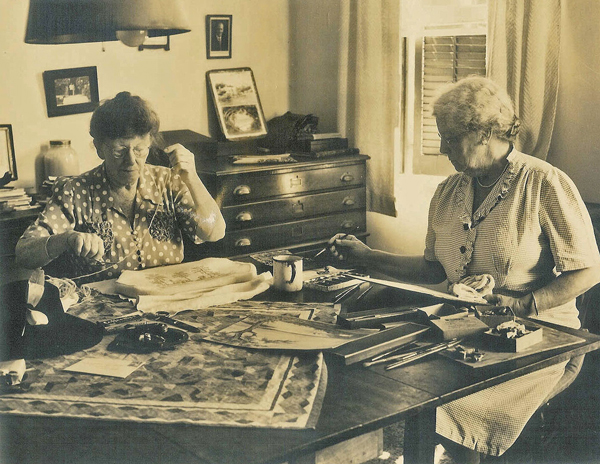 | | Ethel (left) and Kate Tucker at work. Photo Courtesy of Edna Tucker.
| | Ethel and Kate Tucker were pioneering artists and businesswomen whose iconic watercolours won them international renown.
The sisters, who came of age during the late 19th century and were active during the first half of the 20th century, were the first female artists in Bermuda to achieve commercial success.
Never married, they forged an independent, unconventional path, that was strikingly different from the more traditional pursuits of 19th century upper-class white Bermudian women.
Their watercolours and postcards of Bermuda scenes, and souvenirs, won them legions of fans, locally and internationally, during their lifetime, and are sought after by collectors today.
The Little Green Door Tea Garden, which opened on the waterfront at Barr’s Bay, Hamilton in 1909, was an instant success, attracting visiting luminaries such as Mark Twain, Eugene O’Neill and Rudyard Kipling.
Household
Ethel and Kate were two of Robert and Leonora Tucker’s eight children. (Robert Tucker, who was from Church Hill, Somerset, was the Bob in Bob’s Valley, Somerset, according to Bermuda National Trust researchers.) They were raised at Lane House (now Tamarisk Hall ) Paget, a rambling two-storey house at the Foot of the Lane. Although their father was a merchant, money was in short supply in the household but, thanks to their mother, art was not.
Leonora (Smith) Tucker (1847-1925) was one of the Island’s earliest female artists. She found time while raising her brood, to sew her children’s clothes, paint landscapes and design wallpaper and Christmas cards. Several of her children inherited her talent. Ethel, in particular, was said to have been drawing almost as soon as she could walk.
Ethel attended Eliza Williams’ School on Reid Street, graduating in 1892. Kate, who was five years younger, attended Bermuda High School for Girls, likely graduating in 1896.
Ethel’s independent nature emerged during her teenage years. While still in high school, she struck a deal with a teacher to receive art lessons in exchange for playing the piano at a calisthenics class.
She made her own Christmas cards, which she sold at the Women’s Work Exchange. Located in the same building as her high school, the Work Exchange was where women could make extra money selling jams, baked goods and crafts.
After leaving school, Ethel was hired by noted Queen Street photographer James B. Heyl to create ornamental designs, in gold and silver, for the borders of his photo albums. Heyl reportedly had a high regard for her talent—he told her to name her fee and she did.
Governess
In the late 1890s she struck out on her own and moved to New York to study art. A couple of years later, Kate joined her in the big city. Kate initially supported herself by working as a governess. Both attended the New York School of Applied Design for Women (NYSADW ) on scholarship, Ethel from 1898 to 1900, and Kate from 1900 to 1902.
Their benefactor was U.S. War Secretary Elihu Root, a founder of the school, whom Ethel had met in New York. Another supporter was Mrs. Grenville Kane, a wealthy New Yorker who was a director of the school.
The NYSADW, which would merge with the Pratt Institute in 1974, opened in 1892 with the goal of providing women, “especially poor women” with “an affordable practical education that would lead to self-sufficiency”, according to an administrative history of the school, now housed in the Pratt Institute Archives.
Antiques
As struggling artists, the sisters were a perfect fit for the school, whose two-year programme covered a broad range of courses, including art, antiques, architecture and interior design.
In a letter—also in the Pratt Institute Archives —written to Secretary Root in 1900, Ethel said: “It has been a hard struggle to gain the footing I now have, for as you know, I came here depending entirely on my own efforts and should have given up long ago had I not had your scholarship.”
In the same letter, Ethel successfully appealed for a scholarship for Kate. The sisters went to school by day and made cotillion favours at night to help with living expenses. After graduation, Ethel found full-time employment. She enjoyed steady work in New York, as a commercial and interior designer. The sisters ended their time in New York, working as art teachers at their old school.
Kate and Ethel, along with fellow Bermudian artist Helen “May” Middleton, were so highly regarded that in June 1904, NYSADW superintendent Ellen J. Pond sent a letter to the editor of The Royal Gazette, praising Bermuda for producing artists of such calibre. “We feel that Bermuda must be the land of prize students, and wonder who will be the next genius!” Pond wrote.
Watercolours
Around 1909, after 11 years in New York, Ethel, accompanied by Kate, moved back to Bermuda.
It is not clear why, despite having successful careers in New York, they made the decision to return home. One source suggested their mother was ill, but it may well have been a change in family circumstances.
According to the Bermuda National Trust book Bermuda Architectural Heritage Series: Paget, the Tucker family were renters of Tamarisk Hall, where they lived “possibly from “about 1876 to 1910 ”.
But in 1907, Ethel and Kate and their mother inherited property to the east of Tamarisk Hall.
Their architect brother Edward designed and built The Arches on the property and the family moved into their new home in 1910.
By then, Ethel and Kate were bona fide businesswomen. On December 7, 1909, the Little Green Door Tea Garden opened at Barr’s Bay, Hamilton. Kate was the driving force for the venture and the burgeoning tourism industry was the likely impetus.
The tea garden operated during the winter, which was then the high season for tourism. Its waterside spot and menu—tea, buttered and cinnamon toast, nut bread and marmalade and strawberries and cream—made it the go-to place for Bermuda’s elite.
It attracted a string of visiting celebrities including writers Mark Twain (in the final months of his life), Eugene O’Neill and Rudyard Kipling.
The shop was located in a former boat house. An article in The Royal Gazette announcing the opening said: “the grounds have been tastefully laid out, and access is to be gained through what used to be known as the little green door ”.
Mark Twain had his special table, to which Kate later attached a plaque, noting the connection. Author and literary critic William Dean Howells, another regular Bermuda visitor, dined every afternoon with his daughter at his favourite table.
The shop had a dress code: men in shorts were not allowed. Even the Governor’s ADC was turned away after he showed up in shorts following a football game, a gleefully unapologetic Kate said in a 1965 Bermuda Sun interview.
Postcards
The sisters also had gift shop on site, selling paintings, linens and “West Indian baskets”, which expanded with the opening of The Little Green Shop on Queen Street in 1911. Said to be the Island’s first souvenir and gift store, it sold the sisters’ original watercolours, paintings by other artists, Bermuda cedar and other souvenirs, hand-painted silk scarfs, jewellery and embroidered linens.
As demand for their watercolours grew, they embarked on a new venture: postcards. The first in a series of more than 100 different postcards were printed in Germany from Ethel’s painting, Oleanders and Water in Somerset .
With British troops stationed at Prospect during the First World War, forming a ready market, they began producing Christmas cards.
In 1915, the Little Green Shop moved further south along Queen Street to the building that now houses Perot’s Post Office. Business continued to thrive, with the shop functioning both as an art gallery and souvenir shop. Among the celebrity buyers was Edward, Prince of Wales, the future abdicator, who purchased 20 watercolours during a 1920 visit to Bermuda. His mother, Queen Mary, later ordered a set for herself.
Antiques
Between 1915 and 1922, they enjoyed working vacations running tea shop summers, first in Lake Muskoka, Canada, then Lake Placid, New York, and finally St. Augustine in Florida.
In 1918, they took over the operation of lunchrooms in the Women’s Work Exchange, winning praise in the pages of The Royal Gazette, which said their success in business “is a marvel ”.
They later branched out into antiques, opening shops at Reid Street, East Broadway and Castle Harbour Hotel. The sisters also sold their paintings directly to hotel guests.
The tea garden, which changed locations once, remained in operation until 1938. They continued to run the gift shop for another 20 years. Its closing in February 1958, represented the end of an era.
Despite the demands of running two businesses, the sisters were active participants in the Island’s social and cultural life. Both were members of the Bermuda Historical Society, which Ethel is credited with helping to revive.
Kate was a member of the Chamber of Commerce and served on its Council. They donated their talents to organisations like the Imperial Order of Daughters of the Empire and raised funds for war veterans. They also started a club for underprivileged white youth in St. David’s. Ship passenger lists published in The Royal Gazette reveal them to be frequent travellers: they journeyed to the U.K., often on buying trips, the Caribbean and New York.
In 1924, Kate attended the opening of the British Empire Exhibition, where Bermuda had an entry. Ethel was in London the previous year to attend a preliminary session of the exhibition. It is likely the sisters helped design the Bermuda Pavilion, which may have also featured their watercolours.
Voting
Surprisingly, the sisters did not take part in the suffragette movement, which lasted from 1919 to 1944, and whose members, primarily property-owning white women, came from the same social circles.
In a tribute that ran in the Bermuda Historical Quarterly following Ethel’s death in 1962, writer Terry Tucker said the sisters saw little point in women taking on additional responsibilities, such as voting and serving on juries.
Although seemingly inseparable, the sisters had distinctly different personalities. Ethel was reserved, Kate the more outgoing and she also smoked.
Around 1934, Kate was taken to court because the tea garden’s distinctive yellow flag emblazoned with a teapot was deemed by a new police commissioner to contravene a law against commercial advertising. Kate lost the case, which made news in the U.S. Kate felt she got the last word by putting a large black ‘T’ on the flag to get around the law.
They had a sense of humour, were party animals and revelled in their single status. Having attended several 50 th wedding anniversary celebrations, they decided to throw a party for 32 “Old Maids” to celebrate their “50th Anniversary of Simple Blessings.” According to great-niece Wendy Tucker, Ethel later remarked that the party caused quite a “pleasant sensation”.
As painters, the sisters were prolific. They travelled the length and breath of Bermuda, painting hundreds of watercolours. They published a book Glimpses of Bermuda, which featured reproductions of their paintings. Royal Gazette arts critic Marion Robb said in a review of a 1987 exhibition of their work that both developed the “same style of literal yet fresh treatment when they studied in New York ”.
She said there was little to distinguish between their paintings, except Kate put figures in some of her scenes. Marion Robb also noted their paintings “looked rather quaint and romantic beside the bolder versions of 1980s artists ”.
The exhibition, which was held at the Bermuda Arts Centre in Dockyard, also showed the range of their talents: silk scarves, decorated with “Tucker motifs” of birds and flowers” and handbags with their embroidery, were also on display. The sisters also designed brass dinner bells. And in a departure from their bucolic Bermuda scenes, at least one dinner bell depicted a figure of Sally Bassett, the Bermudian slave who was burned at the stake in 1730, according to collector Sandy Campbell.
Attacked
Ethel died in 1962. Kate outlived her sister by eight years. Shockingly in 1966, she was raped and brutally attacked at the home, which she shared with her brother Thomas. Although she sustained a fractured skull and broken jaw, she recovered and lived for four more years. Her assailant, who was apprehended with the help of Scotland Yard, was jailed for 25 years.
More than 50 years after the sisters’ deaths, Tucker sister watercolours, sketches, postcards and memorabilia are collector ’s items internationally and they continue to be recognised locally. Their paintings and postcards are in the collections of the Masterworks Museum and the Bermuda National Gallery.
In 2012, they were the posthumous recipients of a Lifetime Achievement Award from the Bermuda Arts Council. In 2014, Masterworks Museum of Bermuda held an exhibition of their work “Under the Yellow Flag”.
The recent tributes are an indication of the enduring legacy of these pioneering sisters whose success was entirely self-made and who achieved it on their own terms.
Ethel and Kate were not the only members of their family to win recognition outside of Bermuda. Diver and marine explorer Teddy Tucker (1925-2014) was their nephew. 
| | October 10, 1874—Birth of Ethel Tucker
February 28, 1879—Birth of Catharine Tucker
1892—Ethel graduates from Eliza Williams’ high school
1896—Kate graduates from BHS
1898-1900—Ethel attends the New York School of Applied Design for Women on scholarship
1900-1902—Kate attends the same school, also on scholarship.
1900—Ethel enters the workforce in New York, securing a position with the firm Raphael & Tuck as a designer
1903—Ethel and Kate are taken on as art instructors at their art school; Ethel teaches drawing, Kate teaches watercolours
1907—Ethel and Kate and their mother inherit property to the east of Tamarisk Hall; they have The Arches built as their family home
1909—Ethel and Kate return to Bermuda; on December 7, the Little Green Door Tea Garden opens at Barr’s Bay; it is in operation in the winter, the height of the tourist season
1910—The family move into The Arches
1911—The sisters open the Little Green Shop on Queen Street; it is said to be the Island’s first souvenir shop.
1915—The Little Green Shop moves further south on Queen Street
1920—Prince Edward, later King Edward VIII and the Duke of Windsor, purchases 20 Tucker sister watercolours during his first visit to Bermuda; his mother, Queen Mary, later orders a set for herself.
1915-1922 (summers)—Ethel and Kate run tea shops first in Lake Muskoka, Canada, then Lake Placid, New York and finally St. Augustine, Florida.
1920s—Business expands, as Ethel and Kate produce postcards then Christmas cards; Ethel takes on a leading role with the Bermuda Historical Society.
1924—Kate attends the opening of the British Empire Exhibition, where Bermuda has an exhibit.
1926—The sisters establish a club for underprivileged white youth in St. David’s.
Around 1934—The yellow flag with teapot that Kate that has put up for decades is found to be illegal; she gets around the law by modifying it slightly.
1938—The tea garden closes.
1944—Property-owning women get the vote, although Ethel and Kate are said to have had little interest in women’s suffrage.
1958—The Little Green Door closes in February, signifying the end of an era.
1962—Ethel dies on November 16.
1966—In January, Kate is raped at her home; her assailant is convicted and sentenced to 25 years in prison in May
1972—Kate dies on August 22.
1987—A retrospective exhibit of their paintings is held at the Bermuda Arts Centre at Dockyard.
1994—Bermuda National Gallery presents an exhibition The Little Green Door.
2012—Kate and Ethel are posthumous recipients of Lifetime Achievement Awards from the Bermuda Arts Council.
2014—Masterworks Museum of Bermuda Art mounts an exhibition Under the Yellow Flag. “I was a teenager. I used to paint Christmas cards and put them for sale downstairs, all hand-done, you know, with poinsettias and scenes.”
“We had an American lady at the school who gave me painting lessons in exchange for me playing the piano for calisthenics for the other girls.“
“I’m glad I was born without a big purse. We had to make our own way, though it wasn’t considered very fitting for ladies to work. I can recall Kate (Miss Catherine) standing outside the shop cleaning the window and somebody passing saying: ‘Really, Kate, you can’t do that,’ and Kate snapping: ‘Well, I can, you see…’”
“When the Prince of Wales was here (Duke of Windsor now) he sent to the Little Green Shop for some of our work, and we sent some to Government House. He bought it. Some weeks later, we got a letter from London and it started: 'I am commanded by her Majesty….'Queen Mary had sent to buy some of our paintings.”
- Ethel Tucker, The Royal Gazette, November 29, 1959.
“We regret that we are not thirty years younger for we would like to begin all over again. We see many opportunities waiting for the girl who is not afraid of work. Life for us was not all toil by any means; we had our pleasures as well. But we were abroad at an early hour each day, often taking the 8.30 ferry to Salt Kettle in order to display our pictures at the Inverurie Hotel in time to catch the guests as they left the breakfast-table.
“We also ‘caught the early worm’ at the Hamilton and Princess Hotels, while shops in town were just removing their dusters. There were no Permanent Waves in those days, or cocktails. Girls could save their money to develop the best that was in them.”
- Kate Tucker, The Bermudian, April 1946
“I never let the gentlemen enter in shorts. They had to dress nicely. I remember once I turned the Governor’s ADC away because he wore shorts.”
“I put a plaque on the table where Mark Twain sat, in the garden of the tea shop, and you wouldn’t believe the number of people who came along just to have their picture taken at the table. It was a killing!”
"I have had a very happy and strenuous life and enjoyed every minute of it. Mind you, if I had had even a hundred husbands, I would have divorced every single one of them. If I hadn’t had my businesses, I hate to think what sort of person I would be now. Probably an old ‘Meddlesome Mattie!’.” As it is now, I don’t hold grudges against anyone. I have anything to say, I let them have it straight from the shoulder.”
- Kate Tucker, Bermuda Sun, January 23, 1965 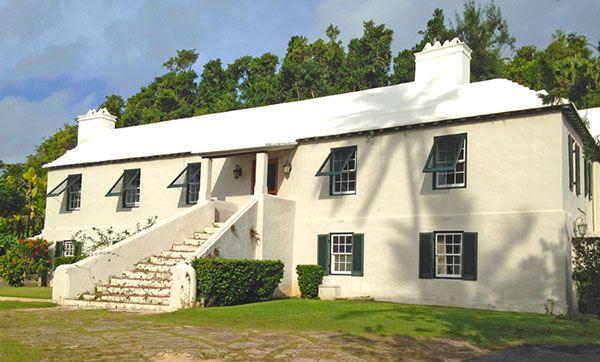 | 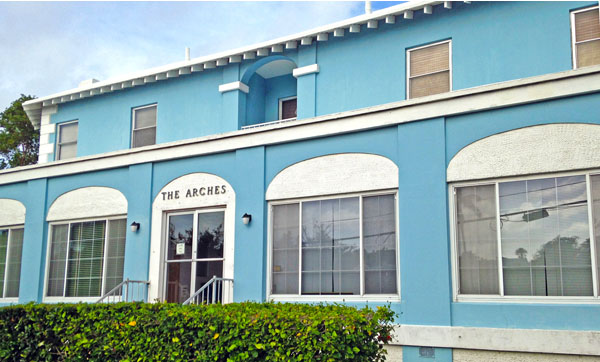 | | Ethel and Kate Tucker were raised at Lane House, Paget, at the Foot of the Lane. The property is now known as Tamarisk Hall (left). Ethel and Kate moved into The Arches, which was built by their architect brother Edward in 1910, and spent the rest of their lives there. The Arches now houses doctors’ offices. | 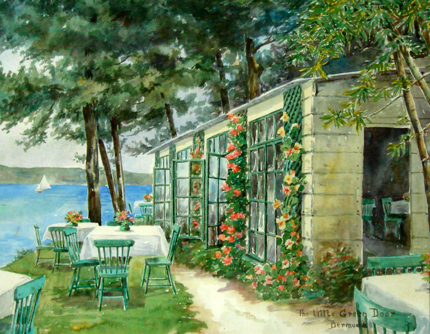 | 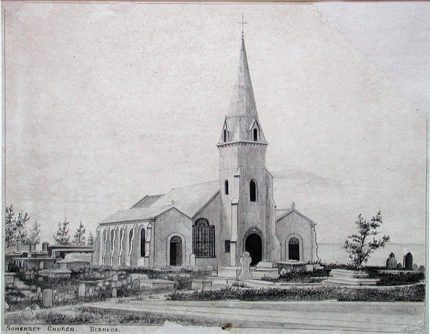 | Catharine F. Tucker painted this image of the iconic tea garden,six years after it opened. It is entitled The Little Green Door, Bermuda, c 1915.
Painting courtesy of the Bermuda National Gallery. | The Tucker sisters inherited their talent from their mother, Leonora. Her painting, Somerset Church, Bermuda, c. 1890, is in the BNG collection.
Painting courtesy of the Bermuda National Gallery. | 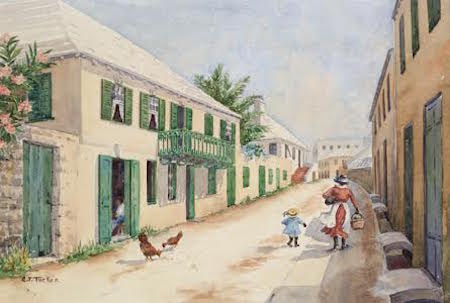 | 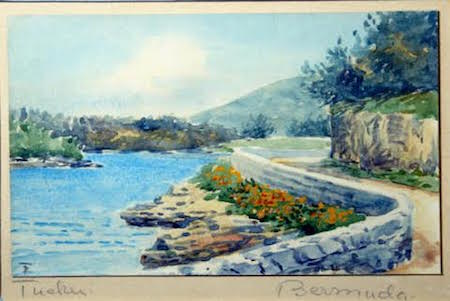 | 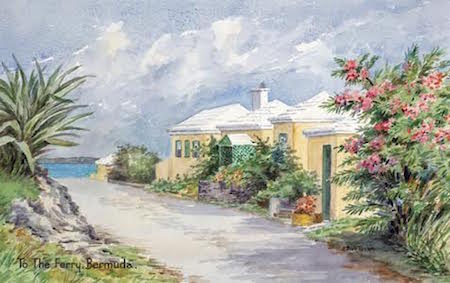 | A sampling of Tucker Sister paintings and postcards.
Courtesy of Masterworks Museum of Bermuda Art |
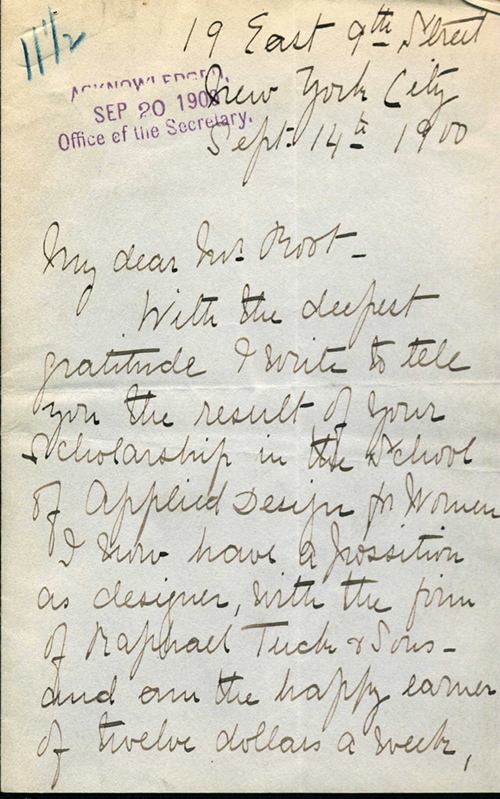
Ethel’s letter of thanks to US War Secretary Elihu Root (right). | My dear Mr. Root,
With the deepest gratitude I write to tell you the result of your scholarship in the School of Applied Design for Women. I now have a position as designer with the firm of Raphael Tuck + Son, and am the happy earner of twelve dollars a week, all for which I have to thank you.
It has been a hard struggle to gain the footing I now have, for as you know, I came here depending entirely on my own efforts and should have given up long ago had I but had your scholarship.
Now I feel as if half my battle is over and shall endeavor to my utmost to prove the good result of my connection with the school.
Whatever my work may be I shall always remember with greatest gratitude that it was you who gave me a start in my career.
Will it be asking too much that you will start another Bermudian? My sister is up here as a governess and is most anxious to study illustration at the school but cannot afford it, so I am going to ask if she may have your scholarship. I spoke to Miss Pond concerning the matter. She said my sister might have it but advised me to consult you first. My sister has a great deal of talent and will be much more credit to the scholarship than I can ever hope to be.
I trust that my request will not seem a selfish one.
I remain always very gratefully,
Ethel Tucker | 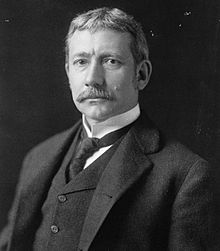 | 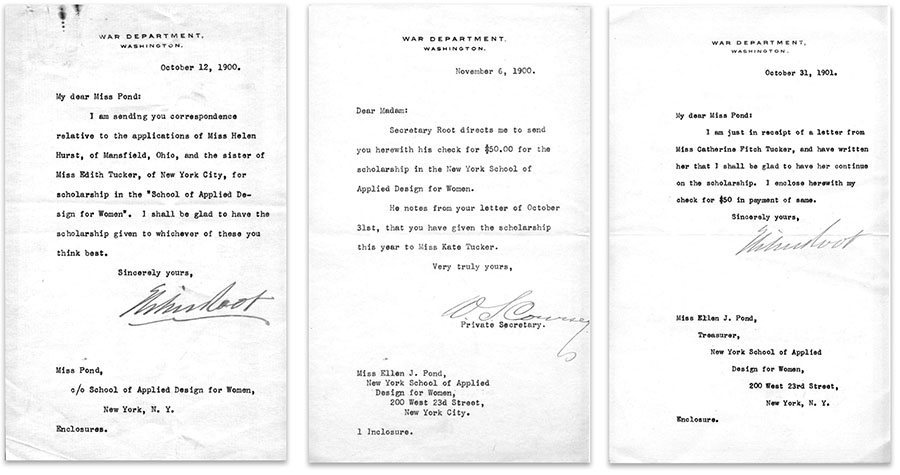 | Correspondence between US War Secretary Elihu Root and NYSADW superintendent Ellen Pond of the NYSADW in regards to a scholarship for Kate Tucker
Credit: The New York School of Applied Design for Women Collection, No. 017. The Pratt Institute Archives, Pratt Institute, Brooklyn, New York. |
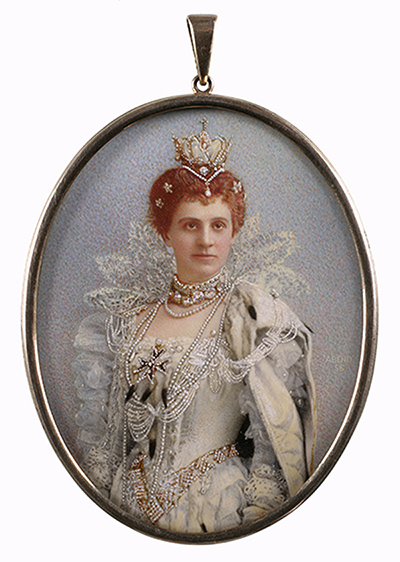 | Left: Mrs. Grenville Kane, a director of the New York School of Applied Design for Women, was a source of support to Ethel during her early years in New York. It is not clear where or how they met. Since Mrs. Kane fit the profile of wealthy US east coast tourists who wintered in Bermuda during the early 20th century, it invites speculation whether Mrs. Kane met Ethel on the island and encouraged her to attend art school.
Mrs. Grenville Kane (1859-1940), miniature, by Albert Abendschein ca. 1900; watercolor on ivory, overall 3 5/8 x 2 7/8 inches; object # 1905.124 The New-York Historical Society www.nyhistory.org
Right: Two views of a paperweight, one of a variety of souvenirs the sisters made for the tourist market.
Credit: Collection of Duncan McDowall and Sandy Campbell | 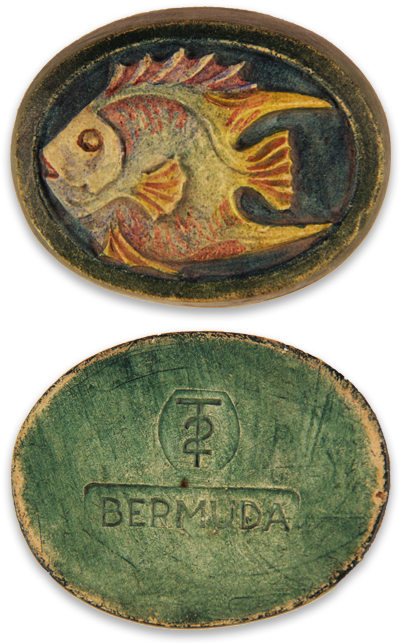 |
Further Reading
“Personalities Roundabout: The Misses Tucker”, The Bermudian, April 1946
“The Talented Sisters”, by Terry Tucker, The Bermudian, September 1961
“Battle of Flags was ‘A Storm Over Teapot’—Story of Colony’s First Tea Shop”, The Royal Gazette, December 3, 1950
“How The Bermuda Christmas Card Industry Started,” The Royal Gazette, November 29, 1959
“Behind the Green Door”, Bermuda Sun, February 11, 1994
Ethel Tucker obituary, The Royal Gazette, November 18 & 20, 1962
Ethel Tucker tribute, Bermuda Historical Quarterly, Winter 1962
Kate Tucker obituary, The Royal Gazette, November 3, 1970
Bermuda Architectural Heritage Series: Paget, Bermuda National Trust, 2010
Additional sources
Issues of The Royal Gazette, 1886-1924
“Women Artists in the Bermuda National Gallery Collection” - essay, Bermuda National Gallery
The New York School of Applied Design for Women Collection, No. 017. The Pratt Institute Archives, Pratt Institute, Brooklyn, New York.
(The editor is grateful to Paul E. Schlotthauer and Ian Post of The Pratt Institute Archives for their assistance)
Interview with great-niece Wendy Tucker, October 2015
Editor’s Note: Kate Tucker’s first name is usually spelled Catherine, but Catharine is the accurate spelling. |

